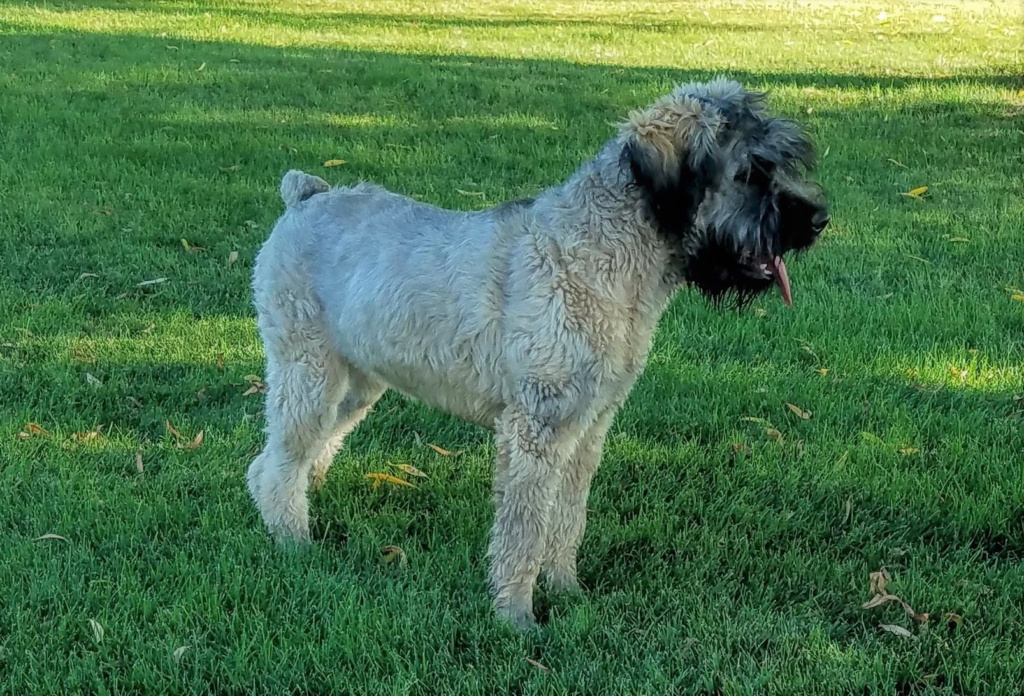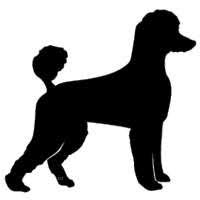“So, what is a Flandoodle?”
A Flandoodle is a cross between a Standard Poodle and a Bouvier des Flanders, less commonly called a Bouvidoodle, Bouvipoo, or Poovier. Both breeds are good with children, very loyal, intelligent, and protective with little to no shedding and hypoallergenic, making this an almost perfect doodle.
The Flandoodle is not recognized by the American Kennel Club or other registries, as it is a cross breed. They are not a hybrid. I do not sell them as a registerable dog. However, this breed is recognized by the Dog Registry of America, Inc. (DRA).
Our male standard Poodle:
SAM
We lost our sweet Sam in November of 2023. At this time we have no immediate plans of replacing him. Rest in peace my goofy, high flying boy.

Female Bouviers:

Annie is a pretty fawn girl out of our retired female Tess. She is 80 lbs. She is almost as tall as her mom.
Available Puppies: (Check the puppy play pen.)
About the breeds.
The Poodle

The Poodle is one of the oldest breeds of dogs ever recognized and has been around since ancient times, originally in Germany but then being perfected in France. They are thought to be a mix of the French, Russian, German, Portuguese, Spanish, and Hungarian Water dogs although the North African Barbet is also part of the mix according to some. Others claim that there are some other breeds mixed in such as Asian herding dogs and other breeds that ran wild during that time. The smaller versions of the Poodle were created in the 1400s by breeding small Poodles with each other. At the time, the Poodle was mainly used for hunting ducks and truffles but became popular as circus dogs and in shows. The AKC officially recognized them in 1887 where they are now the 7th most popular breed of dog.
Bouvier des Flanders
The Bouvier des Flanders started out in Belgium in the 1800s’ herding cattle and pulling carts. Some believe the breed is a mix of Spaniels, Sheepdogs, and Mastiffs while others claim they are a blend of the Griffon and Beauceron. In those days, they were bred only for function so the appearance of the Bouvier des Flanders varied quite a bit. At first, they were called the Toucheur de Boeuf, which means cattle dog, Koehond, which means cow dog, or Vuilbaard, which means dirty beard. The name they have now, Bouvier, means cowherd or oxherd. A veterinarian named Adolphe Reul was a proud breeder who made the Bouvier des Flanders popular during those days even though there was no standard until 1912. Because of the destruction in World War I, the breed’s numbers dropped drastically but a survivor named Nic de Sottegem reignited their popularity after appearing in the Antwerp Olympics in 1920. In 1931, the American Kennel Club recognized the breed and it is now the 83rd most popular breed in America.
Flandoodle
The Flandoodle is a large dog that stands between 22 and 28 inches tall and weighs about 65 to 95 pounds. Their coat is curly and thick, usually medium length or long and although no dog is 100% hypoallergenic, this breed is close to it and does not usually pose any allergy issues. The Flandoodle can be any color but is usually black, gray or brindle. They may be lean or stocky, with well-muscled long legs, a large head, and a furry face with a beard. The long tail is usually docked and their furry ears are pendulous.
Care of your Flandoodle
You will need to brush your Flandoodle on a daily/bi-daily basis to prevent tangling and mats. If his/her coat is especially curly, you may want to have them professionally groomed every few months to keep it manageable. They do not shed much but it is important to bathe them if they get dirty, using mild shampoo and conditioner specially recommended for Poodles. Be sure to clean their ears once a week and watch for redness and ear mites. In addition, you should brush their teeth several times a week to prevent dental problems. They make special toothbrushes and toothpaste specially for dogs that you should use.
Temperament
Your Flandoodle is loving, loyal, and gentle for the most part but needs to be socialized well when he/she is young. They enjoy being part of the family activities and like to play with other animals but may be inclined to hunt smaller animals like rabbits and guinea pigs. They should also be supervised around children younger than five years old. Although they are intelligent and learn quickly, they may be a bit stubborn during training so you have to have patience and use positive reinforcement rather than physical punishment. They can get lonely if left home alone for a long time so they need to have plenty to keep them busy while you are not home.
Activity Requirements:
(Keep in mind that these are all suggestions. If your dog is happy, healthy and content, that is what is important, and just like people, every dog is different and unique.)
The Flandoodle loves activity and needs some type of exercise daily. They love to hunt and would appreciate a trip to the park daily to chase squirrels and rabbits if you do not have a fenced in yard to play in. In addition, having them run alongside you while you jog or bike can also be a beneficial choice for you both. This breed is also good at agility training, Frisbee, fetch, flyball, and swimming. If your Flandoodle does not get as much exercise as it needs, she/he may be likely to develop behavioral problems such as excessive barking, chewing on things, and digging. If this occurs, increase his/her activities.

